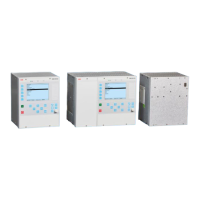Section 5 1MRK 505 350-UEN
Additional protection options
36 Technical Manual
Distributed busbar protection REB500
Section 5 Additional protection options
5.1 Breaker failure protection
5.1.1 Mode of operation
The circuit-breaker is the last and most important link in the protection chain. The
purpose of BFP is to take the right action should the circuit-breaker fail to execute
a trip command. This involves tripping the circuit-breakers surrounding the fault,
which are mainly in the same station, but may also include circuit-breakers at the
remote ends of lines (intertripping).
The principle of BFP is based on monitoring the time the fault persists after a trip
command has been issued to the circuit-breaker (starting of BFP has been enabled
by the main protection, e.g. feeder protection).
A complete block diagram of BFP, including additional functions such as initiation
logics and I0-measurement, can be seen in Figure 8.
The following internal REB500 functions can start the breaker failure function in
all three phases:
• REB500 intertripping system (BBP, BFP, etc.)
• An external trip command
• Time-overcurrent if logic 3 is configured
• Breaker pole discrepancy protection if logic 3 is configured
BFP can be started phase-selectively via two separate inputs. All three phases can
be started via up to 6 different inputs and the currents of all three phases monitored.
It is recommended to adjust the pick-up current of the phase measurement such that
=0.8⋅
.
This setting applies to phase faults und ground faults as well under the condition
that
reflects the minimal short circuit current out of these fault types. In
certain cases, the ground fault current may be much lower than the phase fault
value (e.g. low resistive grounded networks). Under such exceptional cases, the
BFP Io (adjusted with a lower pickup value) can be used in addition to the breaker
failure phase system (see Section 5.2)

